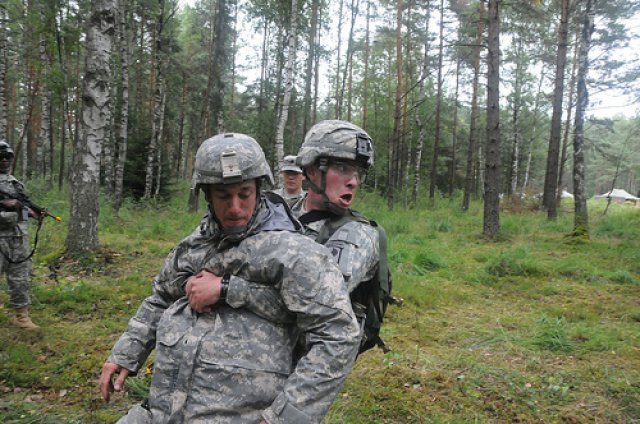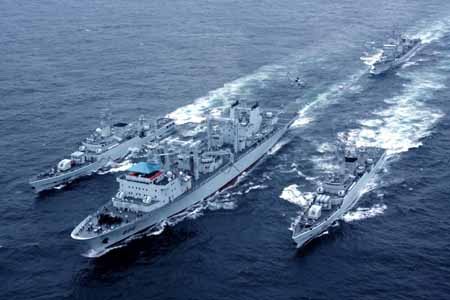In a world where change is routine, the 30th Medical Command (30th MEDCOM) plans for the unexpected. That’s why Lt. Col. Peder Swanson, deputy plans officer at 30th MEDCOM, says his unit’s Soldiers are participating in the new type of exercise at Grafenwoehr Training Area Oct. 3-27.
Europe’s quick reaction force, the 173rd Airborne Brigade Combat Team with members from Vicenza, Italy, and Schweinfurt and Bamberg, Germany, will conduct a brigade attack, offensive, defensive and stability operations, while training with more than 1,000 multinational forces.
The 30th MEDCOM will provide real-world and notional support during the training. They are preparing for an austere environment, non-specific injuries, and to work with their peers from Germany and Great Britain. It’s a new concept. The exercise tests the 173rd ABCT’s ability to conduct operations against a modern, capable hybrid threat, an unknown enemy in an under-developed environment.
Grafenwoehr Training Area provides an enhanced training environment using simulations to stimulate the environment, while the 173rd engages the enemy simultaneously at the Hohenfel’s Training Area.
“We are using the Full-Spectrum Training Environment for the 173rd with a more robust simulation feed to train a medical brigade,” said Col. William D. Jones, chief of the Joint Multinational Simulations Center. “The exercise at Hohenfels isn’t big enough to support the 30th MEDCOM.”
Jones explained the 30th MEDCOM would support all of Afghanistan and contains several field hospitals and its own supply and logistics infrastructure to support the field medical staff. The simulations center has developed a list of events and activities to stimulate the environment, and enlarging the play to enhance the scenarios to accommodate the large-scale mission of the 30th MEDCOM, for example, a mass-casualty event will happen during the exercise. The staff will have to react appropriately.
“We’re preparing to work in tents,” said Maj. Tanner Roy, 30th MEDCOM Plans and Exercises officer. “If we get called in to go to some hotspot, there might not be any infrastructure there for us, so we have to be able to work in any environment.”
Doctors and nurses will treat patients; logistics staff will ensure treatment supplies are delivered and available when needed, despite the austere environment.
Roy said leaders resolved to train under the new doctrine, Army Field Manual 3-0, after the 30th MEDCOM returned from Afghanistan in 2010. “We want them [Soldiers] to be confident they can operate in a full-spectrum threat environment, and use their know-how anywhere and in all types of operations,” Roy said.
Roy said the unit will provide medical support at all phases of the operation, from the beginning to the stability operations at the end. There will be approximately 750 individuals on the ground participating in the exercise, including members of the 212th Combat Support Hospital and the 421st Multifunctional Medical Battalion.
Swanson said the 212th CSH breaks ground on a new early entry hospital during the exercise.
“It’s easier to airlift into an austere environment,” he said.
The 212th CSH staff is being augmented by medics and staff from the U.S. Air Force, the United Kingdom, and Germany, which creates a joint, multinational medical environment.
In Europe, U.S. Soldiers regularly train with multinational partners. In fact, during Operation Enduring Freedom 38 of the 45 Troop Contributing Nations supporting the International Security Assistance Force, more than 85 percent of the coalition forces in Afghanistan, were trained at the U.S. Army Europe’s Joint Multinational Training Command.
This year, there were almost 300 candidates competing for the USAREUR Expert Field Medical Badge, of those, five were from the German Bundeswher, two from the U.S. Navy and one was from the U.S. Air Force.
Roy says training together, provides multinational and U.S. Soldiers common standards and objectives for treating the sick and wounded.
“Because of the numerous threats throughout the world, we need to be able to respond to basically anything,” Roy said. “We want to be able to use this training to get full-scale, real-life training on full-spectrum operations.”
Swanson said the most noticeable difference between this exercise and those previous will be its relative austerity, as the new doctrine emphasizes the period surrounding entry into a country, when infrastructure like standing hospitals may not be in place.
“There’s a whole lot of planning involved for entering a new environment,” Swanson said. “If you’re the first people hitting the ground, as opposed to falling into where other units have been, you’ve got to train and fight differently.”
Jones said the medical command has a few things to consider.
“They’ve got to execute command and control of their brigade, provide theater-level support, while having a couple of command posts to move-around,” he said. “Not to mention providing preventive medicine, air-and-ground medical evacuation and providing healthcare and casualty support.”
He said the Full-Spectrum Training Environment maximizes the training value for USAREUR units.
“It’s provides more realistic training for multi-functional and support brigades than a standard Command Post Exercise,” said Jones. “It creates efficiency. You’re not supporting an imaginary brigade. 30th MEDCOM is supporting the 173rd ABCT, and it’s a better training event for 30th MEDCOM.”











